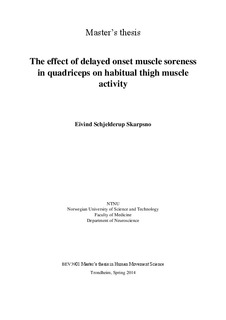The effect of delayed onset muscle soreness in quadriceps on habitual thigh muscle activity
Master thesis
Permanent lenke
http://hdl.handle.net/11250/264307Utgivelsesdato
2014Metadata
Vis full innførselSamlinger
Sammendrag
Objective: The main purpose of this study was to investigate the effect of acute quadriceps pain, caused by delayed onset muscle soreness (DOMS), on long-term habitual muscle activity in knee extensors and flexors. A second purpose was to investigate the effect of DOMS on controlled muscle activation in the laboratory, and to compare this with the habitual recordings.
Methods: Eighteen healthy subjects (10 females and 8 males, mean age 23 years, range 20-31) participated in the study. Surface electromyography (sEMG) was recorded bilaterally from vastus lateralis, rectus femoris, vastus medialis and biceps femoris on two weekdays with one day of rest between recordings. The laboratory tests (standing, walking in stairs, standing up from a seated posture, isometric contraction, and maximal voluntary contraction [MVC]) were performed before the long-term field recordings. Body posture (sitting, standing, and walking) was recorded with an accelerometer, and heart rate was recorded with electrocardiography (ECG). Immediately after the first long-term recording, the subjects performed an eccentric exercise (Barbell lunges) with use of the dominant leg only. Pressure pain threshold (PPT), pain scored on visual analogue scale (VAS) and maximum force during a maximal isometric contraction were used to assess symptoms of DOMS.
Results: There were no differences in time spent in different body postures or heart rate between the first and second long-term recording. DOMS was indicated by a significant reduction of PPT in the quadriceps muscle, a significant raised VAS-score, and a significant reduction in maximum knee extension force in the exercised leg. Habitual sEMG activity (median sEMG level, μV) of the antagonist in the exercised thigh increased from first to second long-term recording during seated posture, while sEMG activity in the exercised vastus medialis decreased from first to second long-term recording during periods with standing posture (P<.05 for both comparisons). Thigh sEMG activity remained unchanged for the untrained leg in all postures during the long-term recordings. During the laboratory tests, sEMG activity of the antagonist of the painful thigh increased during walking in stairs (P=.003), but remained unchanged in other controlled contractions. When comparing standing posture in the laboratory with standing posture during the long-term field recording, the same tendency was observed, i.e., decreased agonist and increased antagonist activity in the exercised leg.
Conclusion: The present findings indicate that DOMS has no or only moderate effect on muscle activity, and the results indicates that the responses to muscle pain is not so stereotypical as suggested by the pain adaption model. Thus, the current findings support the notion that pain models should include a task dependency aspect.
Key words: Delayed onset muscle soreness, electromyography, vastus lateralis, rectus femoris, vastus medialis, biceps femoris, posture, habitual activity patterns, vicious cycle theory, pain adaption model
